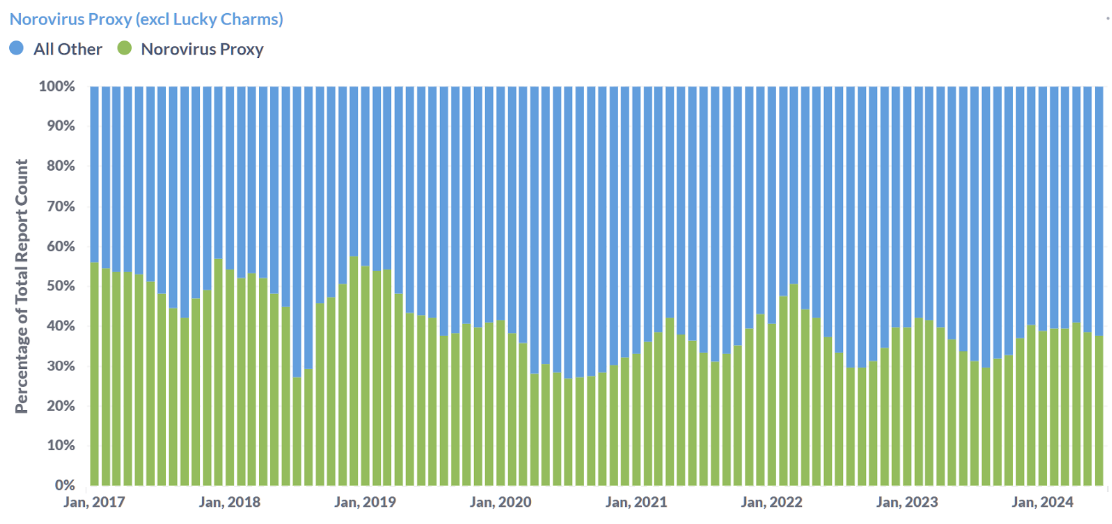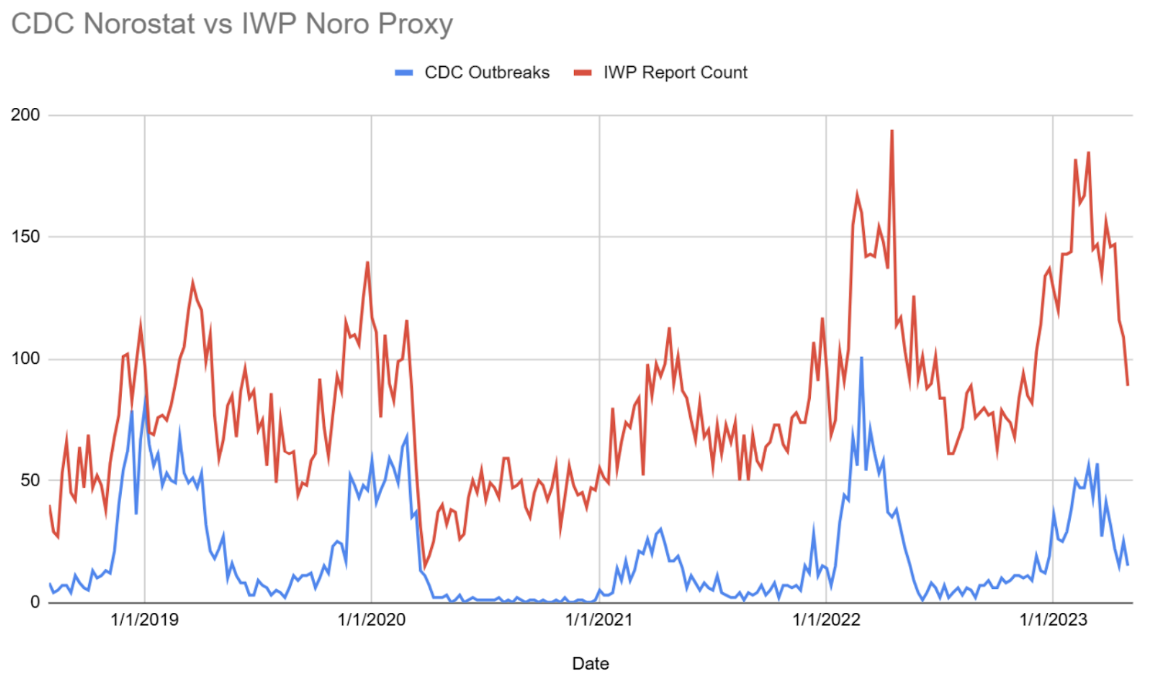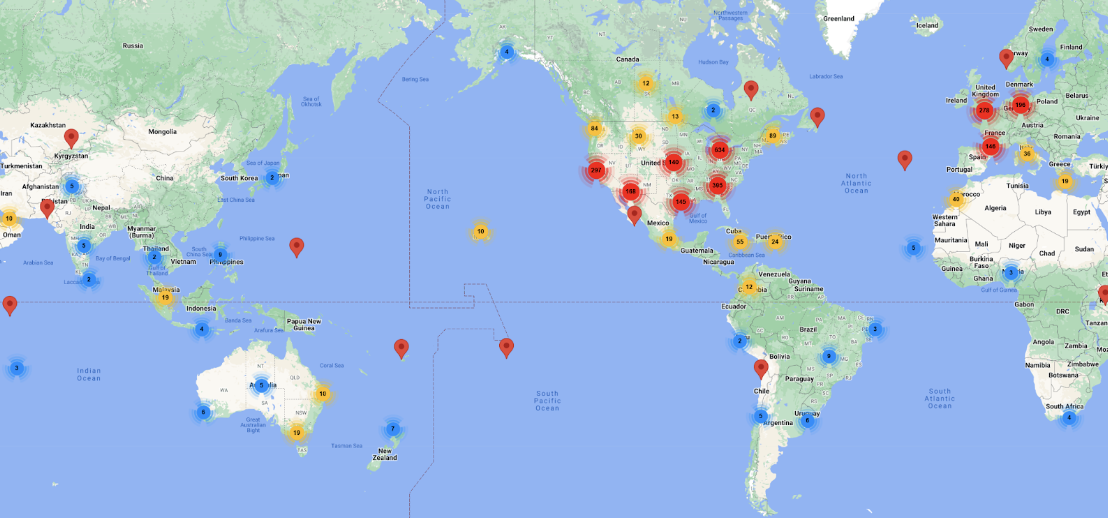Report by
Understanding the Norovirus Challenge
Norovirus is a leading cause of foodborne illness globally, presenting significant challenges for public health monitoring. It is a highly contagious virus that spreads through direct contact with an infected person, contaminated food or water, or by touching contaminated surfaces. Norovirus prevention focuses on safe food handling, hand hygiene, and disinfecting surfaces.In the U.S. alone:
- It is estimated Norovirus is responsible for about 20 million cases of acute gastroenteritis each year
- 50% of all foodborne disease outbreaks are due to norovirus
- 70% of food-related outbreaks are attributed to infected food handlers
Our Norovirus Score is a new metric designed to quantify the likelihood of norovirus activity in a given area. By analyzing self-reported symptoms that closely align with norovirus infection—particularly the co-occurrence of vomiting and diarrhea—we generate a score that can indicate potential outbreaks. This approach provides real-time insights, aiding in early detection and response to norovirus incidents.
Table of Contents
Our MethodologyIntroduction to NoroSTAT
Introduction to Iwaspoisoned
Statistical Analysis Utilized
Our Study’s Findings
Our Norovirus Score
Seamless Integration and Enhanced Monitoring
Connect With Us
Our Methodology
To validate the effectiveness of our Norovirus Score, we conducted a study that investigated the correlation between self-reported norovirus-like illness from IWP and norovirus epidemiological data from NoroSTAT:- IWP provides data that consists of individual, self-reported illness accounts, offering real-time insights directly from consumers.
- On the other hand, NoroSTAT involves aggregate data on confirmed norovirus outbreaks, which represents a more traditional method of data collection through public health channels.
Introduction to NoroSTAT
- NoroSTAT is the Norovirus Sentinel Testing and Tracking network, a collaborative effort by select U.S. state public health departments and the CDC.
- NoroSTAT was launched to improve norovirus outbreak reporting.
- Participation in these systems is optional - only fifteen states participate in NoroSTAT
- The network collects epidemiologic and laboratory data on suspected or confirmed norovirus outbreaks, providing a benchmark for our analysis.

Introduction to Iwaspoisoned - Data Collection and Cleaning
When consumers report on IWP, they are prompted to fill out a symptoms field. For this study, we used proxies due to the absence of mandatory laboratory confirmations for norovirus. We identified vomiting and diarrhea as key indicators for potential norovirus cases on IWP. Our focus on vomiting and diarrhea was based on clinical reasoning, these are strong and unique indicators of norovirus infection. Notably, vomiting is a hallmark symptom of norovirus.- Crowdsourced Data: We collected self-reported symptoms from IWP, focusing on reports featuring both vomiting and diarrhea as key indicators of norovirus infection.
- Data Cleaning: Processes were applied to exclude spam and duplicate reports, ensuring the accuracy and reliability of our dataset.

- Pearson Correlation: This method measures the strength and direction of the linear relationship between two variables. In our study, it helped identify how closely our crowdsourced data matched the official norovirus outbreak reports from NoroSTAT.
- Granger Causality Tests: These tests assess whether one-time series can predict another. We used them to determine if changes in our crowdsourced data could predict changes in official NoroSTAT outbreak reports.

- Pearson Correlation: We found a value of 0.669 (p<0.001), indicating a strong linear relationship between the IWP data and the NoroSTAT data. A Pearson coefficient close to 1 suggests a strong positive correlation, so this result demonstrates a meaningful alignment between the two data sets.
- Granger Causality Analysis: This analysis showed a highly significant directional correlation (p=0.003), suggesting that our crowdsourced data could potentially predict official norovirus outbreak reports.
Our Norovirus Score
Unlike traditional methods that may experience delays, our Norovirus Score provides real-time information that could enable fast response times to potential outbreaks.Key Advantages to IWP Data:
- Location-specific data: Allows for targeted interventions and efficient resource allocation.
- Immediate Actionable Data: Enables quicker response times to potential outbreaks.
- Data Visualization: Users can view trends, hotspots, and patterns in norovirus-like illness reports. Such tools help identify areas of concern and track the progression of potential outbreaks over time.

